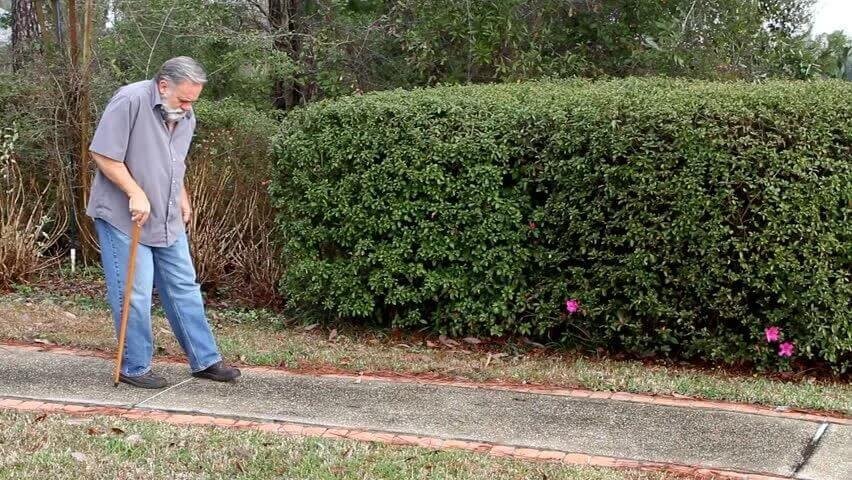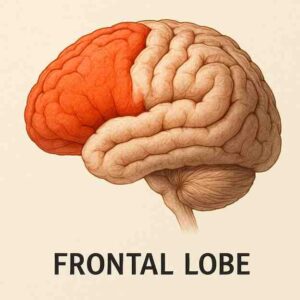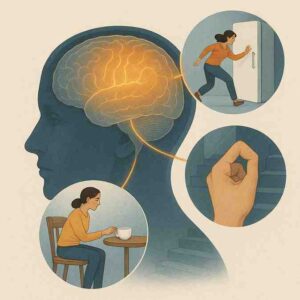The key to treating a patient who has a walking problem is to observe their gait carefully and diagnose them accurately
“You’ve got a compression in your thoracic spine,” I proclaimed, as I saw 68-year-old Mr. Shaikh shuffle towards the door of my consulting room that I was holding ajar for him. He wore a white kurta and adorned a long stringy silvery beard to go with it. I usually refrain from making any diagnosis until I listen to a patient’s complete history and perform a detailed examination, but his short stiff steps that seemed a little out of his own control gave it away. His wife held one arm while I firmly gripped the other, as we gently helped him into his chair and allowed him to tell me why he was here.
‘I’ve been diagnosed with Parkinson’s,” Mr. Shaikh said. “I’ve been taking medication for a while but its only getting worse. I was feeling better than James Bond just a few years ago,” he lamented, remembering an earlier, healthier time. He appeared fidgety with his hands, which was probably assumed to be a tremor by his treating doctor. Patients with Parkinson’s have an extremely stoic looking face, often deadpan, and they blink very little, but he seemed pretty animated in expressing his difficulty in walking. “Do you wake up in the middle of the night and shout sometimes?” I asked; some patients with Parkinson’s have a sleep behavioural disorder. “She does that!” he jested, pointing to his wife. “That’s because he gets up and turns the light on every few hours to pass urine,” she said giving me another clue in the puzzle.
I examined him to find his upper limbs devoid of the usual rigidity that we expect in Parkinson’s, but his legs were stiff as logs. While he sat on the examining bed facing me, I tapped on his knees with a neurological hammer and his feet briskly sprung up in the air and back. If you are positioned directedly in front of a patient while doing this, you can injure vital parts of your anatomy, but with experience, you learn where to stand. However, as I remember reading somewhere, experience is something I’d like to have without going through all the trouble of getting it.
“Sometimes, progressive degenerative conditions of the brain and spine have several mimics,” I finally asserted, and to confirm my suspicion, continued with, “It would be best to get an MRI of the spine.”
He returned within a few weeks, this time taking a little longer to position himself than he did the last time he was here.“You’re right, doctor, the report does mention severe compression,” he said, while his wife handed over the MRI films to me. I slid the scan into the groove of the light box and showed them where the ligament over the fourth and fifth thoracic vertebrae had thickened, thinning the spinal cord considerably. This MRI visual is one that most patients seem to intuitively understand, instantly relating it to being responsible for their symptoms. “This will need an operation, Mr. Shaikh. We’ll position you on your belly, make an incision over the upper part of your back, drill off the bone, and bite off the thickened ligament, giving the spinal cord its rightful space. Over the next few months, your gait will improve dramatically,” I said confidently. “Will I go back to being James Bond?” he wondered aloud. “Shaikhen but not stirred,” I punned, but he didn’t smile. I’ll admit it wasn’t a very good joke.
We operated on him a few days later. We cut down from skin to bone, cleanly dissecting the muscle off it. I then drilled a trough on either side of the bone and lifted the back of the vertebra in a single piece. We nibbled all over the thickened ligament as the compressed covering of the spinal cord finally came to the surface, one bite at a time, assuming its normal rounded position, free and breathing easy. “I already feel less tight in my legs,” he muttered in his partly conscious state, as we wheeled him out of the operating room. A few months later, when he came in to see me, he looked several years younger. His walk was swift and smooth, with perfect cadence and in complete control. “Do you feel like James Bond now,” I asked, after seeing him so relieved and happy. “I just bought an Aston Martin!” he quipped.
In any patient who has a problem walking, diagnosing it rightly is the key to successfully treating it. I remember, as a child, standing with my dad on the balcony of our home and identifying gait disorders. We have a garden in front of our house, and as the number one advice given by any doctor to someone who has a walking problem is that the patient should take a walk, we were treated to a spectrum of ailments we had fun identifying. Sometimes, when I disagreed with my dad, I would run down to ask the person walking if what he had was indeed what my father said he did, and was amazed by his clinical acumen when we got an affirmative answer. There was someone who would walk a few quick steps, then freeze, and then repeat the pattern. “That’s the propulsive gait of Parkinson’s,” my dad taught me when I was eight. Then, there was someone who would swerve his leg out with every step. “This guy has had a stroke and residual hemiparesis,” I learnt.
People who have an excess accumulation of fluid within the ventricles tend to walk with a broad-based gait, as if their feet were refusing to leave the ground. The gait is referred to as magnetic and is seen in patients with a condition called normal pressure hydrocephalus. Patients who have a foot drop slap their foot on the ground making a distinct sound;often, just hearing (not seeing) a patient walk can establish the diagnosis. A painful or an antalgic motion could either be because of arthritis of the knee or hip or spinal stenosis, and oftentimes patients can have both; my orthopaedic colleague and I have constantly discussed the overlap. Children with cerebral palsy have a scissoring gait where their feet crisscross while walking.
After thus learning about different kinds of gaits as a medical student, I once took profound responsibility for the knowledge I had and went up to someone in the garden across my house. I told them they walked this way because they had a slipped disc and needed to be urgently evaluated. “I’m sorry, young man,” the elderly gentleman kindly told me, putting his best foot forward, “it’s just a shoe bite from an ill-fitting shoe I’m dealing with!”





